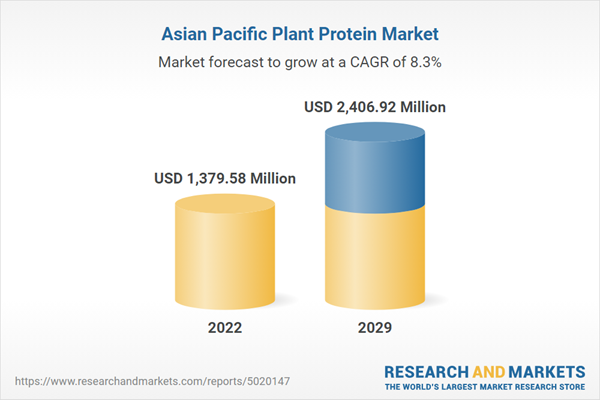Plant-based proteins are produced using plant-based sources, like soy, pea, and wheat, among others, and are then further processed to create a finished product. They have been finding a wide range of applications in the food and beverage industries as well as the animal feed industry. These plant-based proteins come in a variety of forms and are used in place of meat in several food items.
To increase the nutritional content of beverages and other dietary products, plant-based proteins, such as those in peas and chickpea protein, among other sources, are added. As a result, many health-conscious individuals are gravitating towards plant-based proteins due to the increasing awareness of diets high in protein.
Furthermore, plant-based food options are growing as a result of partnerships between major food chains and restaurants and investments. For instance, China-based Starfield raised $100 million in a series B round of funding in January 2022.
Additionally, the rising frequency of health issues such as obesity which is leading to shifting consumer habits and millennials' sustainable eating habits coupled with increased awareness of animal welfare are propelling the Asian market forward. Countries such as Singapore, Thailand, and others are embracing the vegan trend as a plan to attract more tourists to the region.
Furthermore, vegetarianism has massively been inspired by Hinduism and Buddhism in Asia, there are currently 1.1 billion Hindus and almost 500 million Buddhists worldwide whereas more than 90% of Hindus reside in India. Hence, growing inclination toward vegan diets and the functional efficiency of plant protein sources, and their rising usage in a broad variety of processed foods, especially in ready-to-eat goods, are driving the Asia Pacific plant protein market.
Moreover, central governments have played a pivotal role in fostering the growth of the Asia Pacific food and beverage plant-based protein market. They have done so by advocating for sustainable agriculture practices and providing incentives to encourage innovation and research, complementing the increasing consumer demand for plant-based proteins.
Notably, the market for plant-based meat in India is projected to experience substantial expansion, with estimates suggesting a surge from the current valuation of US$ 30-40 million to US$ 500 million, as reported by a government source on ibef.org.
Increased health awareness and enhanced innovations
The improving economic scenario along with rising awareness regarding the nutritional value of plant-proteins in developing nations has led to the growth in the Asia Pacific plant-based protein market. Due to its simple digestion, sustainable source, excellent nutritive quality, non-allergic nature, affordability, and ethical considerations, consumers are more likely to choose plant protein. Plant-based proteins are a growing industry in the Asia Pacific region. Growing population and booming economies in developing countries have increased local demand for protein. Soy and other plant-based proteins are witnessing as increase in production. China leads the world in soy protein output, followed by Indonesia and India.Moreover, by combining plant proteins with their cultivated fat ingredients, Mission Barns keeps coming up with new ideas. They are even closer to bringing their products to market with the U.S. FDA's recent approval of UPSIDE Foods' cultivated chicken, a meat product. Plant-based ingredients are being used by SCiFi Foods, TissenBio Farms, and Meatable to reduce the price of their cultivated meat.
Further, the increasing demand for soybean is also leading to market growth, for instance, India is ranked fifth in terms of production of soybean with 11.23 million tonnes in 2020-21 and fourth in terms of area with 12.12 million hectares (29.94 million acres), or 8.86% of the world's total area.
Moreover, the Plant-based Protein Topical Report claims that as Chinese consumers seek out more protein in their diets, plant-based meals become more widely available and alluring. According to the report, the knowledge of plant-based proteins has reached 90%, and the retention rate has increased from 53% in October 2020 to 68% in January 2021.
Key Players:
- Ingredion is a leading global ingredient solutions provider. They produce nutrition ingredients, biomaterials, sweeteners, and starches that consumers use in everyday goods like beverages, food items, paper goods, and medications. To make crackers crunchy, candies sweet, yoghurt creamy, lotions and creams silky, plastics biodegradable, and tissues softer and stronger, they process grains, fruits, vegetables, and other plant materials into ingredients.
- Roquette is a renowned supplier of pharmaceutical excipients and a pioneer in plant-based ingredients. By utilizing nature's potential to provide the best ingredients for food, nutrition, and health markets, the group works with its clients and partners to address present and future societal issues.
- Scoular Company, through its networks and innovations in international trade and transportation, provides dependable and diverse supply chain solutions for end users and suppliers of grain, food ingredients, animal feed ingredients, and pet food ingredients.
Segmentation:
By Source
- Pea
- Rapeseed
- Soy
- Hempseed
- Others
By Form
- Protein Concentrates
- Protein Isolates
- Protein Hydrolystae
By Application
- Dietary Supplement
- Food and Beverages
- Pharmaceuticals
- Animal Feed
By Distribution Channel:
- Online
- Offline
By Geography
- Japan
- China
- India
- South Korea
- Indonesia
- Vietnam
- Malaysia
- Singapore
- Philippines
- Others
Table of Contents
Companies Mentioned
- Ingredion Inc.
- Roquette Frères
- Wilmar BioEthanol (Wilmar International)
- Herbalife Nutrition Ltd.
- Kerry Inc. (Kerry Group)
- The Scoular Company
- ADM
- Amway
- DuPont
- DSM-Firmenich
Table Information
| Report Attribute | Details |
|---|---|
| No. of Pages | 90 |
| Published | March 2024 |
| Forecast Period | 2022 - 2029 |
| Estimated Market Value ( USD | $ 1379.58 Million |
| Forecasted Market Value ( USD | $ 2406.92 Million |
| Compound Annual Growth Rate | 8.2% |
| Regions Covered | Asia Pacific |
| No. of Companies Mentioned | 10 |









